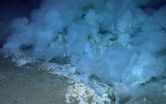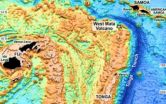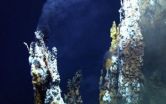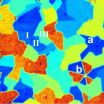(Press-News.org) More than a mile beneath the ocean's surface, as dark clouds of mineral-rich water billow from seafloor hot springs called hydrothermal vents, unseen armies of viruses and bacteria wage war.
Like pirates boarding a treasure-laden ship, the viruses infect bacterial cells to get the loot: tiny globules of elemental sulfur stored inside the bacterial cells.
Instead of absconding with their prize, the viruses force the bacteria to burn their valuable sulfur reserves, then use the unleashed energy to replicate.
"Our findings suggest that viruses in the dark oceans indirectly access vast energy sources in the form of elemental sulfur," said University of Michigan marine microbiologist and oceanographer Gregory Dick, whose team collected DNA from deep-sea microbes in seawater samples from hydrothermal vents in the Western Pacific Ocean and the Gulf of California.
"We suspect that these viruses are essentially hijacking bacterial cells and getting them to consume elemental sulfur so the viruses can propagate themselves," said Karthik Anantharaman of the University of Michigan, first author of a paper on the findings published this week in the journal Science Express.
Similar microbial interactions have been observed in shallow ocean waters between photosynthetic bacteria and the viruses that prey upon them.
But this is the first time such a relationship has been seen in a chemosynthetic system, one in which the microbes rely solely on inorganic compounds, rather than sunlight, as their energy source.
"Viruses play a cardinal role in biogeochemical processes in ocean shallows," said David Garrison, a program director in the National Science Foundation's (NSF) Division of Ocean Sciences, which funded the research. "They may have similar importance in deep-sea thermal vent environments."
The results suggest that viruses are an important component of the thriving ecosystems--which include exotic six-foot tube worms--huddled around the vents.
"The results hint that the viruses act as agents of evolution in these chemosynthetic systems by exchanging genes with the bacteria," Dick said. "They may serve as a reservoir of genetic diversity that helps shape bacterial evolution."
The scientists collected water samples from the Eastern Lau Spreading Center in the Western Pacific Ocean and the Guaymas Basin in the Gulf of California.
The samples were taken at depths of more than 6,000 feet, near hydrothermal vents spewing mineral-rich seawater at temperatures surpassing 500 degrees Fahrenheit.
Back in the laboratory, the researchers reconstructed near-complete viral and bacterial genomes from DNA snippets retrieved at six hydrothermal vent plumes.
In addition to the common sulfur-consuming bacterium SUP05, they found genes from five previously unknown viruses.
The genetic data suggest that the viruses prey on SUP05. That's not too surprising, said Dick, since viruses are the most abundant biological entities in the oceans and are a pervasive cause of mortality among marine microorganisms.
The real surprise, he said, is that the viral DNA contains genes closely related to SUP05 genes used to extract energy from sulfur compounds.
When combined with results from previous studies, the finding suggests that the viruses force SUP05 bacteria to use viral SUP05-like genes to help process stored globules of elemental sulfur.
The SUP05-like viral genes are called auxiliary metabolic genes.
"We hypothesize that the viruses enhance bacterial consumption of this elemental sulfur, to the benefit of the viruses," said paper co-author Melissa Duhaime of the University of Michigan. The revved-up metabolic reactions may release energy that the viruses then use to replicate and spread.
How did SUP05-like genes end up in these viruses? The researchers can't say for sure, but the viruses may have snatched genes from SUP05 during an ancient microbial interaction.
"There seems to have been an exchange of genes, which implicates the viruses as an agent of evolution," Dick said.
All known life forms need a carbon source and an energy source. The energy drives the chemical reactions used to assemble cellular components from simple carbon-based compounds.
On Earth's surface, sunlight provides the energy that enables plants to remove carbon dioxide from the air and use it to build sugars and other organic molecules through the process of photosynthesis.
But there's no sunlight in the deep ocean, so microbes there often rely on alternate energy sources.
Instead of photosynthesis they depend on chemosynthesis. They synthesize organic compounds using energy derived from inorganic chemical reactions--in this case, reactions involving sulfur compounds.
Sulfur was likely one of the first energy sources that microbes learned to exploit on the young Earth, and it remains a driver of ecosystems found at deep-sea hydrothermal vents, in oxygen-starved "dead zones" and at Yellowstone-like hot springs.
Dick said the new microbial findings will help researchers understand how marine biogeochemical cycles, including the sulfur cycle, will respond to global environmental changes such as the ongoing expansion of dead zones.
SUP05 bacteria, which are known to generate the greenhouse gas nitrous oxide, will likely expand their range as oxygen-starved zones continue to grow in the oceans.
INFORMATION:
In addition to Anantharaman, Dick and Duhaime, co-authors of the Science Express paper are John Breir of the Woods Hole Oceanographic Institution, Kathleen Wendt of the University of Minnesota and Brandy Toner of the University of Minnesota.
The project was also funded by the Gordon and Betty Moore Foundation and the University of Michigan Rackham Graduate School Faculty Research Fellowship Program.
Undersea warfare: Viruses hijack deep-sea bacteria at hydrothermal vents
Unseen armies of viruses and bacteria battle in the deep
2014-05-01
ELSE PRESS RELEASES FROM THIS DATE:
Excessive regulations turning scientists into bureaucrats
2014-05-01
Excessive regulations are consuming scientists' time and wasting taxpayer dollars, says a report released today by the National Science Board (NSB), the policymaking body of the National Science Foundation and advisor to Congress and the President.
"Regulation and oversight of research are needed to ensure accountability, transparency and safety," said Arthur Bienenstock, chair of the NSB task force that examined the issue. "But excessive and ineffective requirements take scientists away from the bench unnecessarily and divert taxpayer dollars from research to superfluous ...
Electronic nose sniffs out prostate cancer using urine samples
2014-05-01
New York, NY, May 1, 2014 – We may soon be able to make easy and early diagnoses of prostate cancer by smell. Investigators in Finland have established that a novel noninvasive technique can detect prostate cancer using an electronic nose. In a proof of principle study, the eNose successfully discriminated between prostate cancer and benign prostatic hyperplasia (BPH) by "sniffing" urine headspace (the space directly above the urine sample). Results using the eNose are comparable to testing prostate specific antigen (PSA), reports the Journal of Urology®.
Prostate cancer ...
Oral Cancer linked to human papillomavirus: No increased HPV risk for long-term partners
2014-05-01
Partners of patients diagnosed with human papilloma virus (HPV)-positive oropharyngeal cancer (OPC) were no more likely to test positive for oral HPV infection than people in the general population, according to a study published in the April 28 online edition of the Journal of Clinical Oncology. The findings should lessen anxiety that OPC cancer is contagious, at least among long-term partners, and confirms that couples who have been together for several years do not need to change their intimacy or sexual behavior because of the cancer diagnosis.
HPV infection is common ...
Study in Science finds missing piece of biogeochemical puzzle in aquifers
2014-05-01
A study published today in Science by researchers from the U.S. Department of Energy's Argonne National Laboratory may dramatically shift our understanding of the complex dance of microbes and minerals that takes place in aquifers deep underground. This dance affects groundwater quality, the fate of contaminants in the ground and the emerging science of carbon sequestration.
Deep underground, microbes don't have much access to oxygen. So they have evolved ways to breathe other elements, including solid minerals like iron and sulfur.
The part that interests scientists ...
Increased drought portends lower future Midwest crop yields
2014-05-01
Increasingly harsh drought conditions in the U.S. Midwest's Corn Belt may take a serious toll on corn and soybean yields over the next half-century, according to research published today in the journal Science.
Corn yields could drop by 15 to 30 percent, according to the paper's estimates; soybean yield losses would be less severe.
North Carolina State University's Roderick Rejesus, associate professor of agricultural and resource economics and a co-author of the Science paper, says that corn and soybean yields show increasing sensitivity to drought, with yields ...
Tapah downgrades to a depression
2014-05-01
Tapah was downgraded from a tropical storm to a tropical depression and is located 239 nautical miles southeast of Iwo To. Tapah rapidly dissipated due to the effected of strong vertical windshear from the west and a sharp decreased in sea surface temperature. The storm is currently tracking northwest at 10 knots per hour and is expected to recurve to the northeast and accelerate. Maximum wave height is currently 10 feet. The storm will be monitored for signs of regeneration.
NASA captured this image of the storm with the Moderate Resolution Imaging Spectroradiometer ...
Researchers link age, general health and antidepressant use with eye disorders
2014-05-01
Abnormal binocular vision, which involves the way eyes work together as a team, increases dramatically as we age, according to research from the University of Waterloo. The study also found a correlation between this condition, general health and antidepressant use.
As many as 27 per cent of adults in their sixties have an actual binocular vision or eye movement disorder. That number rises to 38 per cent for those over age 80. About 20 per cent of the general population suffers from a binocular vision disorder, which affects depth perception and therefore may increase ...
New Hass avocado research presented at American Society for Nutrition Scientific Sessions
2014-05-01
May 1, 2014 [San Diego, CA] – New research exploring the potential effects of Hass avocado consumption on emerging cardiovascular disease (CVD) risk factors was presented at the American Society for Nutrition Scientific Sessions and Annual Meeting at Experimental Biology 2014 (EB).
Li Wang, PhD Candidate, Pennsylvania State University, presented, "Avocado consumption decreases LDL particle number and small, dense LDL cholesterol in overweight and obese subjects," at the Dietary Bioactive Components: Cardiovascular Effects of Dietary Bioactive Components session on Saturday ...
Edgy look at 2-D molybdenum disulfide
2014-05-01
The drive to develop ultrasmall and ultrafast electronic devices using a single atomic layer of semiconductors, such as transition metal dichalcogenides, has received a significant boost. Researchers with the U.S. Department of Energy (DOE)'s Lawrence Berkeley National Laboratory (Berkeley Lab) have recorded the first observations of a strong nonlinear optical resonance along the edges of a single layer of molybdenum disulfide. The existence of these edge states is key to the use of molybdenum disulfide in nanoelectronics, as well as a catalyst for the hydrogen evolution ...
Some Ohio butterflies threatened by rising temperatures
2014-05-01
The combined heat from climate change and urbanization is likely to reduce the number of eastern swallowtails and other native butterflies in Ohio and promote the spread of invasive relatives, a new study led by a Case Western Reserve University researcher shows.
Among 20 species monitored by the Ohio Lepidopterists society, eight showed significant delays in important early lifecycle events when the two factors were combined—a surprising response that may render the eight unfit for parts of the state where they now thrive.
Butterflies serve as important indicator ...
LAST 30 PRESS RELEASES:
Rare image of Tatooine-like planet is closest to its twin stars yet
Music: Popular song lyrics have become more negative since 1973
Marine ecology: Killer whales tail dolphins to hunt salmon
ADHD prescriptions on the rise, study finds
How to build a genome
Sharp rise in ADHD stimulant prescriptions in Ontario, research finds
Trends and prevalence of the metabolic syndrome among US adults
Population-level trends in ADHD medication prescribing
Missing piece of myelin disturbs the brain’s rhythm
Insilico Medicine and Taigen achieves license agreement to develop and commercialize AI-driven PHD inhibitor for anemia of Chronic Kidney Disease (CKD)
Exploring dominant endophytic Pleosporales in grasses: New taxonomic insights in the suborder Massarineae
Comparative transcriptomic analysis of human maxillary and mandibular tooth germs reveals discrepancies in gene expression patterns
Scientists detect atmosphere on molten rocky exoplanet - study
Chip-scale magnetometer uses light for high-precision magnetic sensing
Illinois Tech biomedical engineering professor Philip R. Troyk elected as Fellow of the National Academy of Inventors
The National Academy of Inventors welcomes 2025 Class of Fellows
Multi-scale modelling framework predicts mechanical responses of Fe–Cr–Al alloys across composition and processing conditions
Preoperative radiation may improve antitumor immune response in most common form of breast cancer
Breast MRI may be safely omitted from diagnostic workup in certain patients with early-stage, HR-negative breast cancer
Sentinel lymph node biopsy may be safely omitted in some patients with early-stage breast cancer
Rats may seek cannabis to cope with stress
New FAU research strengthens evidence linking alcohol use to cancer
Gut health à la CAR T
Dr. Pengfei Liu receives 2026 O'Donnell Award in Medicine for pioneering advances in genetic diagnostics and rare disease treatment
Dr. Yunsun Nam receives 2026 O'Donnell Award in Biological Sciences for pioneering RNA research transforming gene regulation and cancer therapy
Dr. Bilal Akin wins 2026 O'Donnell Award in Engineering for transformative work in EV energy systems and industrial automation
Dr. Fan Zhang receives 2026 O'Donnell Award in Physical Sciences for groundbreaking discoveries in quantum matter and topological physics
Dr. Yue Hu receives 2026 O'Donnell Award for revolutionizing energy operations with real-time AI and reinforcement learning
Greater risk that the political right falls for conspiracy theories
JMC Publication: Insilico’s AI platforms enable discovery of potent, selective, oral DGKα inhibitor to overcome checkpoint resistance
[Press-News.org] Undersea warfare: Viruses hijack deep-sea bacteria at hydrothermal ventsUnseen armies of viruses and bacteria battle in the deep





